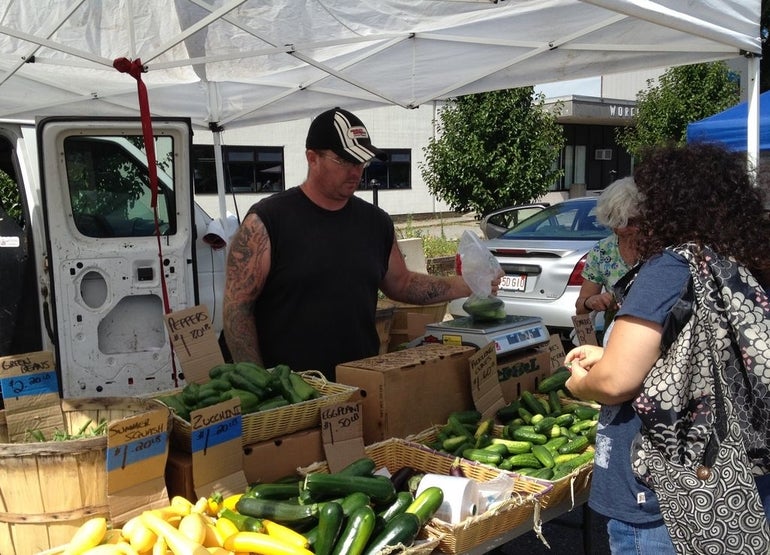Farming with her husband in Oxford for 29 years, Fran Shivick is known at local farmers markets as the “Tomato Queen,” and wears the title proudly, airbrushed in bright red and yellow on her white T-shirt and hat.
She stood behind wooden crates full of dozens of tomatoes on a recent afternoon at Worcester’s farmers market in the parking lot at Beaver Brook Park, telling customers that the vegetables she offered were picked fresh that morning and that, although not certified organic, they weren’t sprayed with pesticides.
“It gives you a satisfaction when you know what you’re selling, compared to what you get in a store,” she said.
Shivick brings her produce to markets in Holden, Worcester and Oxford and said she could “definitely not” sustain her 9-acre farm without them. And she has more markets to choose from than ever.
According to the Federation of Massachusetts Farmers Markets, the number of markets in the state has nearly tripled, growing from 92 in 2002 to 251 in 2012.
“The overarching driver is that, as a culture, we are much more focused on local food,” said Executive Director Jeff Cole. “With the increase in fuel prices, in 2008-2009 in particular, the products that were shipped here were very, very expensive … It allowed (local farmers) to be much more competitive.”
However, that competitiveness hasn’t come without its share of hardships.
Saturation’s Downside
Cole said that, although more consumers are coming to markets, sales per market are down because there are so many.Which means farmers must spend more time away from the fields, attending more markets, to make money. As a rule of thumb, Cole’s organization says a market should pull in 100 customers per farmer.
“That generally produces enough for farmers to make it sustainable,” he said.
Cole said the saturation of farmers markets in some areas of the state have caused farmers to stop participating.
“The growth of farmers markets has placed a lot of stress on the farmer’s side of the industry,” he said.
Many farmers must either decide to either hire people for the market or to handle things at the farm while they’re manning a booth.
“In either case, that radically changes the nature of their work,” he said. “No matter how you slice and dice it, going to farmers markets takes the farmers’ hands out of the dirt. The majority of farmers, that’s not why they got into farming, and they get to a certain point where they say, ‘That’s not what I want.’”
Although the high number of markets causes these strains, markets are an integral tool, particularly for marketing, Cole said.
When he and his wife started their Sutton farm in 1981, they had a roadside stand where they sold 60 cents worth of peas the first day. Then, they took advice to go to a Worcester farmers market.
“Not only did we increase our sales dramatically, but because we were only 10 miles from downtown Worcester, it became a marketing tool,” he said, adding that markets can be key to farmers who aren’t in a good location for a stand, although it’s cheaper to run a farm stand: market fees can range from $0 to $60.
But for many, the costs are worth it.
Pete Plaskon of E.L. Silvia Farms in Dighton stood behind what was the largest stand at the Beaver Brook market and helped a steady crowd of customers vying for produce. He said that between the farm’s owner and him, they attend 10 markets a week. “We have a farm stand, but it doesn’t do very well,” he said, adding that there’s a supermarket nearby that he thinks hurts business.
“(On) a lot of things, we’re more expensive than a grocery store,” Plaskon said. “It’s a different culture of people who shop at markets.”
However, Bobby Jo Samek, of Brook Gardens in West Brookfield, said farmers see a lot of regulars. More than 30 years after Samek’s father started attending markets, they’re still viewed as “a necessity” to sell.
“The farm stands do good, but still, to get it out there is one of the most important things,” he said.
Meanwhile, Ron Starcher and his wife have been farming their 31 acres in Brookfield for five years and are still feeling out which markets are best for them. They attend six a week. Starcher said the markets are vital for Town Farm Gardens’ success, which is needed more today since he recently quit his job and farming became their sole income.
“Small farmers have fewer outlets for their produce,” he said. He explained that right now, their farm is small enough that it’s not a decision of whether to attend markets, but which ones and how many.
n
Read more

